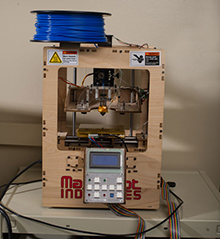Inside UAB's 3D Superstore
By Matt Windsor
Looking for a 12th century chess piece? A custom Rubik’s cube? An exact copy of a seashell, the inside of an eyeball, a relief map of an Egyptian burial ground, or an obscure protein?
 A scanner in the UAB 3D Print Lab gathers the data needed to turn virtually anything into a printable object. See more examples in this slideshow. UAB computer scientist Kenneth Sloan, Ph.D., has them all in stock. If you’re searching for something else—anything else—he can get it. Or, to be precise, make it. Just give him a day or two, and $20 per cubic inch.
A scanner in the UAB 3D Print Lab gathers the data needed to turn virtually anything into a printable object. See more examples in this slideshow. UAB computer scientist Kenneth Sloan, Ph.D., has them all in stock. If you’re searching for something else—anything else—he can get it. Or, to be precise, make it. Just give him a day or two, and $20 per cubic inch.
Inside Sloan’s lab on the ground floor of Campbell Hall are five 3D printers, ranging from entry level to commercial grade. These magic machines, which recently earned a spot on the cover of Wired magazine, transform computer files into reality. Instead of ink, their “print heads” extrude a thin stream of superheated plastic in layers seven-thousands of an inch thick. Building layer upon layer, a 3D printer can make a nearly infinite variety of objects.
 The hobbyist-level MakerBot (above) is one of five 3D printers in the lab, which include several commercial-grade devices. The spool at top left holds the plastic, which is heated and deposited in ultra-thin slices to form objects.Sloan and his students have made life-size models of Tetris pieces, intricate puzzles, and elaborate contraptions that could be produced in no other way. But these “toys” only offer a hint of what is possible, Sloan says. The printers’ true value is becoming clear as other UAB researchers come to the 3D Print Lab with their own designs.
The hobbyist-level MakerBot (above) is one of five 3D printers in the lab, which include several commercial-grade devices. The spool at top left holds the plastic, which is heated and deposited in ultra-thin slices to form objects.Sloan and his students have made life-size models of Tetris pieces, intricate puzzles, and elaborate contraptions that could be produced in no other way. But these “toys” only offer a hint of what is possible, Sloan says. The printers’ true value is becoming clear as other UAB researchers come to the 3D Print Lab with their own designs.
“It took us a long time to get to the point where someone can walk in the door with a computer file describing their object and we can deliver the part to them the next morning,” says Sloan. “But now we’re ready to offer this service to the UAB community”—at the bargain price of $20 per cubic inch printed.
Several UAB researchers have already taken advantage of the service, producing everything from models of the inner eye to a test tube holder that will be used to train a new generation of astronauts. Read on to learn more about three fascinating collaborations.